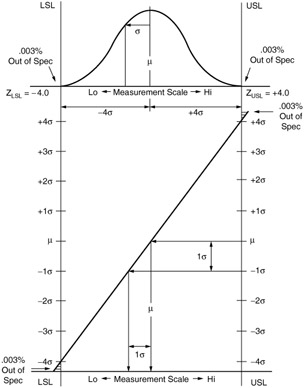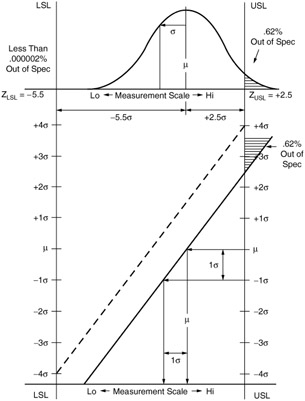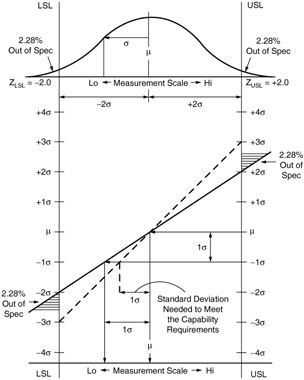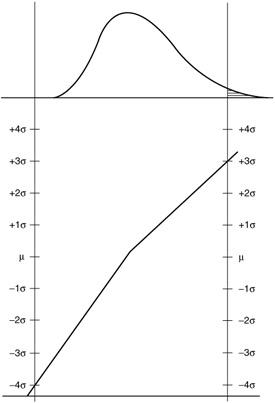PROCESS POTENTIAL STUDY
A process potential study (PPS) has a minimum expected performance of 99.994 percent or ±4 ƒ .
DESIGN CHARACTERIZATIONS FOR PPS
Limit the source of variation. The source of manufacturing variation is artificially limited during a PPS. Carefully consider process stream effects and the critical elements of the process to be studied. A process flow chart will help you during the study. The sample for a PPS is usually a series of parts made consecutively by a single machine or element of a manufacturing system. Using consecutive parts reduces the influence of unplanned sources of variation in the study design. One hundred ( n = 100) or more parts should be used for these studies. This amount of data is needed for analysis of the distribution shape. To test the distribution, you may want to use a histogram or probability paper.
Do not adjust the equipment during the study. All setup activities should be conducted before the trial production run. Adjustment and changes in the machinery should not be made during the study period. The variation between setup procedures and adjustments should be separated from the specific source of variation being studied.
Use a precise measurement device. Measurement is not a perfect activity and is a source of variation. This element of variation should be kept out of the PPS. The instruments, testers, or gages that are used to collect data should have a known level of error (see Chapter 15). The characteristic should be measured so that at least 10 data categories are possible within the specification limits. The categories should account for the resolution of the measurement device and measurement error.
Produce, measure, and record the study parts and data in sequence. The parts that make up the sample subgroup should be produced, measured, and recorded in sequence. Maintain the time order to simplify problem solving. The parts should also be numbered and stored for later reference. Witness marks and analysis of related characteristics are especially important when a process does not demonstrate potential for fulfilling the capability requirements.
NORMAL PROBABILITY PAPER
Normal probability paper analysis is constructed so that data from a PPS can be analyzed graphically. The density of the normal distribution (Z values and proportions from Table 5.1) is used to divide the vertical axis. The horizontal axis is divided into equal spaces and represents the measurement scale of the characteristic being studied. Data from the PPS is plotted on the grid paper with a line of best fit drawn through the plotted data. This line is drawn so that it is as close as possible to each of the data points. The line of best fit is compared with the characteristic specifications and interpreted for capability. This technique is a graphical solution to the analysis made with standardized values (Z values; see Chapter 12). Figures 16.2 through 16.6 show the relationship between analyses using frequency polygons and standardized values and plots on normal probability paper.
Figure 16.2 shows distributions centered between the specification limits ( ±3 ƒ ). The frequency polygon at the top of the figure was constructed with techniques outlined in Chapter 2. The normal probability plot at the bottom of the figures was constructed with the techniques detailed in Chapter 12. The distribution is represented by the diagonal line between the specification limits. This line intersects the specification limits (the vertical axes) at heights equal to standardized values (Z). The normal probability slot provides the same information given by the frequency polygon and standardized values. The diagonal line crosses the vertical axis at ±3 standard deviations.

Figure 16.2: The relationship of frequency polygons, standardized values, and normal probability paper on a ±3 ƒ arrangement.
Figure 16.3 describes a distribution that is centered between the specification limits and the mean is four standard deviations away from both of the specification limits. The frequency polygon and standardized values (Z USL and Z LSL ) indicate that 0.003% of the distribution is outside of the specification limits.

Figure 16.3: The relationship of frequency polygons, standardized values, and normal probability paper on a ±4 ƒ arrangement.
The normal probability plot at the bottom of the figure also shows the capability level of the distribution. The diagonal line crosses the specification limits at ±4 standard deviations. The angle of the diagonal line represents the spread of the curve. Curves that have less spread (a smaller range or standard deviation) have diagonal lines that are closer to being vertical. Larger spreads are represented with lines of fit that are closer to the diagonal.
The vertical axis of normal probability paper is scaled with standard deviations. These marks may be used to estimate the standard deviation of the distribution. The distance between the mean and the standard deviation mark is transferred horizontally to the diagonal line. The distance is then projected downward to define the distance of one standard deviation on the measurement scale. These distances are identified on the normal probability plots.
The process that is represented by the curve and normal probability plot in Figure 16.4 is not capable. The frequency polygon (at the top of the figure) shows that the mean is too close to the upper specification limit (USL). The standardized value for the upper specification is equal to 2.5. This means that the USL is 2.5 standard deviations from the mean. About .62% of the distribution is beyond the USL.

Figure 16.4: The relationship of frequency polygons, standardized values, and normal probability paper showing rejects on the high side of specification.
The normal probability plot (at the bottom of the figure) also indicates the lack of capability. The diagonal line that represents the process data crosses the right vertical axis, or USL, at a height of 2.5 standard deviations. The diagonal line is closer to the USL than the LSL. The location of the diagonal line from left to right shows the position of the data relative to the specifications. The mean in Figure 16.4 is located close to the USL. This is shown in both the frequency polygon and the normal probability plot. The process may be made capable by adjusting the mean to the center of the specifications limits (see the dotted diagonal line in Figure 16.4). The spread of the process does not have to be changed to fulfill the capability requirements. Because the angles of the dotted and solid diagonal lines are equal, the spreads of the two curves are equal.
Figure 16.5 also shows a distribution that does not fulfill capability requirements. The distribution has too much spread (i.e., the standard deviation and range are too large) to fit within the specification limits. To make this process capable, the spread must be reduced. The dotted diagonal line in Figure 16.5 was drawn so that it crosses the specifications at ±3 standard deviations. This shows the spread needed to fulfill the minimum definition of process capability. The actual size of the needed standard deviation can be estimated by projecting the distance of 1 standard deviation from the diagonal line down to the measurement scale.

Figure 16.5: The relationship of frequency polygons, standardized values, and normal probability paper showing rejects on both sides of the specifications.
The distribution illustrated in Figure 16.6 does not follow the shape of the normal distribution because it is not symmetrical. The frequency polygon at the top of the figure is skewed. The normal probability plot shows the nonnormality by the bend in the diagonal line. The data cannot be represented with a single straight line. The skewness or asymmetry in the data can only be fit by two straight lines or a curved line. This means that the data do not follow the slope of a normal distribution. Standardized values (Z) and percentages based on the normal curve should not be used for these data. (The capability analysis must be preformed with the techniques discussed in Chapter 12.)

Figure 16.6: The relationship of frequency polygons, standardized values, and normal probability paper of a skew distribution.
Advantages of Normal Probability Paper
Using normal probability paper to summarize data from a PPS has several advantages, as we already have discussed in Chapters 12 and 14. Let us emphasize some key points here as they relate to machine acceptance:
-
People are often uncomfortable when required to calculate and interpret standardized values (Z). Making plots on normal probability paper deemphasizes calculations and focuses on the graphical summary and interpretation data. It is also quick.
-
The shape of the distribution influences the line that best fits the normal probability plots. Distributions that follow the normal probability function are best drawn with a straight line. Distributions that are skewed, truncated, or bimodal are represented with lines of best fit that are curved or nonlinear. Figure 16.7 illustrates the case of nonnormal data plotted on normal probability paper. The distribution is also shown as a frequency polygon.

Figure 16.7: A bimodal curve presented in a polygon form and on probability graphical representation. -
Normal probability plots facilitate what-if analysis. People who analyze data from capability studies often want to know the values of the process average and standard deviation that would fulfill the capability requirements. This is especially important when the manufacturing system is not capable. Although these estimates may be made by using standardized values (Z), many people find that the estimated values are easier and faster to use in interpreting normal probability plots.
A bimodal curve is portrayed in Figure 16.7. This type of curve has more than one mode or peak. This is another example of a group of data that does not follow the shape of the normal distribution. The two peaks are shown in both the frequency polygon and the normal probability plot.
An S -shaped plot on normal probability paper signals a bimodal distribution. These distributions are frequently a result of more than one major source of variation having been combined into one sample. The different sources of variation do not have the same location of mean. This process is called a process stream effect. Different machines, shifts of production, workers, setup parameters, lots of materials, or machine pallets are possible sources of process streams.
The data used to create Figure 16.7 may have come from two machines. Some parts may have been produced with one machine and some with another. If this is the case, the two machines should be investigated and evaluated. Adjustments should be preformed before analyzing the capability levels of the equipment.
STEPS FOR PLOTTING DATA ON NORMAL PROBABILITY PAPER
We discussed the individual steps for plotting in Chapter 12. Here we only mention them:
-
Measure and record the data.
-
Assess the stability of the process.
-
Make a frequency distribution and histogram for the data.
-
Transfer the frequency distribution to the front of the capability analysis sheet.
-
Calculate the estimated accumulated frequency for each measurement.
-
Calculate the percentages.
-
Plot the percentages on the normal probability scale.
-
Draw a line of best fit through the plotted percentage points.
-
Estimate the natural limits of the curve.
-
Interpret the level of capability.
If the distribution is not normal, follow the steps that were defined in Chapters 12 and 14.
CONTROL CHART SIGNALS AND THEORY
In Chapter 11, we discussed in detail the control chart signals; however, when evaluating machines for the purpose of accepting them for production purposes, one of the requirements is to review and evaluate the control charts . The reader is encouraged to review Chapter 11; in this section, we will mention only some of the key signals. They are
-
Points out of UCL and/or LCL
-
Trends
-
Cycles
-
Runs
-
Unusual variation or stratification (points too close to the center or too close to the limits)
-
Zone control
-
Analysis of runs
EAN: 2147483647
Pages: 181